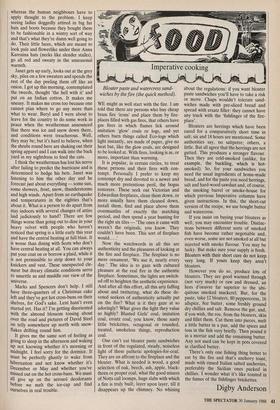a Imperative cooking
Bloater paste and watercress sand- wiches by the fire (the quick method).
WE might as well start with the fire. I am told that there are persons who buy cheap brass fire 'irons' and place them by fire- places filled with gas fires, that others have gas fires in which flames lick around imitation 'glow' coals or logs; and yet others burn things called Eco-logs which light instantly, are made of paper, give no heat but, like the glow coals, are designed to be looked at. With fires, looking is as, or more, important than warming.
It is popular, in certain circles, to treat these persons and their fires with con- tempt. Personally I prefer to keep my contempt dry and devoted to a newer and much more pretentious peril, the bogus restorers. These seek out Victorian and Edwardian fireplaces, clean them down, or more usually have them cleaned down, install them, find and place above them overmantles of exactly the matching period, and then spend a year hunting for the right six tiles — 'The ones it came with weren't the originals, you know. They couldn't have been. This sort of fireplace would....'
Now the watchwords in all this are authenticity and the pleasures of looking at the fire and fireplace. The fireplace is no mere ornament, 'We use it, nearly every day.' The idea is to gaze with cultured pleasure at the real fire in the authentic fireplace. Sometimes, the lights are switch- ed off to heighten the aesthetic experience. And after all this effort, all this arty faffing about and twittering, what do these de- voted seekers of authenticity actually put on the fire? What is it they gaze at so adoringly? What gives the light they value so highly? Blasted Girls' coal, imitation coal, ersatz coal, you know, those nasty little brickettes, octagonal or rounded, treated, smokeless things, reproduction coal.
One can't eat bloater paste sandwiches in front of the regulated, steady, noiseless light of these pathetic apologies-for-coal.
They are an affront to the fireplace and the bloater. What is needed is wood, a good selection of oak, beech, ash, apple, black- thorn or proper coal, what the good miners of Notts call loomps, huge slabs with which a fire is truly built, layer upon layer, till it disappears up the chimney. No whining about the regulations: if you want bloater paste sandwiches you'll have to take a risk or move. Chaps wouldn't tolerate sand- wiches made with pre-sliced bread and spread with ersatz filler: they cannot have any truck with the 'fishfinger of the fire- place'.
Bloaters are herrings which have been cured for a comparatively short time in salt; six and 18 hours are mentioned. Some authorities say, no saltpetre; others, a little. But all agree that the herrings are not gutted. This produces a stronger flavour. Then they are cold-smoked (unlike, for example, the buckling, which is hot- smoked). So, for your sandwiches you need the usual ingredients of home-made bread, and for the paste you need herrings, salt and hard-wood sawdust and, of course, the smoking barrel or smoke-house for which previous Imperative columns have given instructions. In this, the short-cut version of the recipe, we use bought butter and watercress.
If you insist on buying your bloaters as well, you may encounter trouble. Distinc- tions between different sorts of smoked fish have become rather negotiable and, even worse, some are not smoked at all but injected with smoke flavour. You may be lucky. But make sure your supply is fresh. Bloaters with their short cure do not keep very long. If yours keep they aren't bloaters.
However you do so, produce lots of bloaters. They are good warmed through (not very much) or raw and dressed, an hors d'oeuvre far superior to the ubi- quitous smoked mackerel. But, for the paste, take 12 bloaters, 80 peppercorns, 16 allspice, 8oz butter, some freshly ground dry chillies and salt. Remove the gut, and, if you wish, the roe, from the bloaters, skin and fillet them. Cut them into pieces, melt a little butter in a pan, add the spices and toss in the fish very briefly. Then pound it in a mortar and add the remaining butter. Any not used can be kept in pots covered in clarified butter.
There's only one fishing thing better to eat by the fire and that's anchovy toast, made with rinsed Italian salted anchovies, preferably the Sicilian ones packed in chillies. I wonder what it's like toasted in the fumes of the fishfinger brickettes.
Digby Anderson


















































 Previous page
Previous page